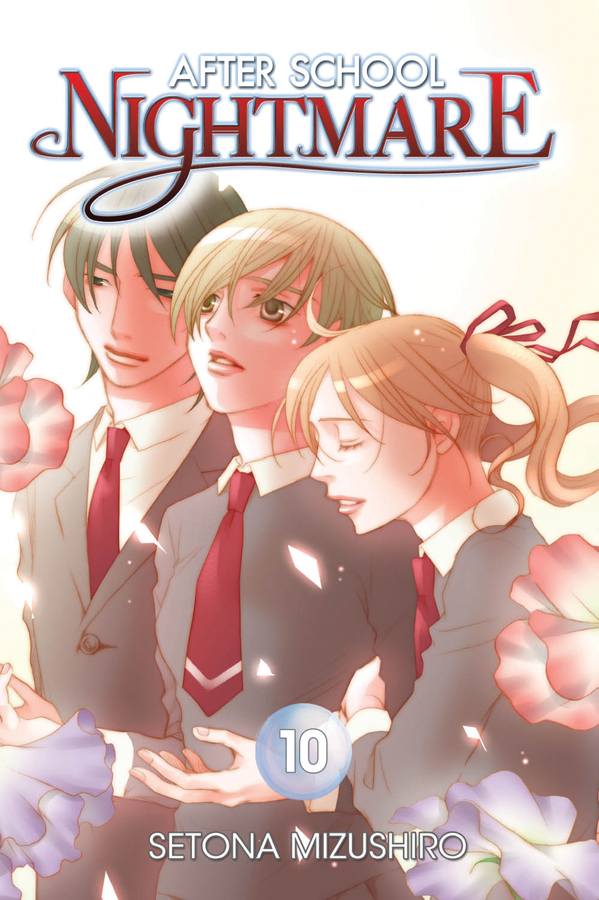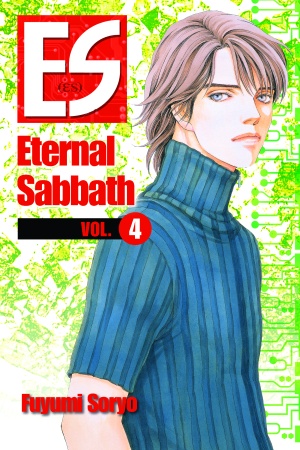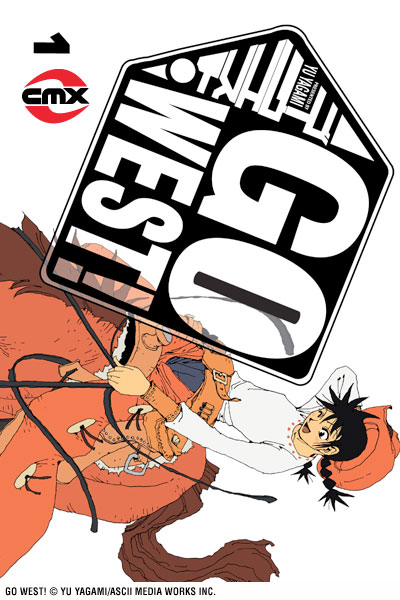 David Welsh looks at this week’s new releases, but he’s fixated on one book: The final volume of After School Nightmare, in which everything finally comes together.
David Welsh looks at this week’s new releases, but he’s fixated on one book: The final volume of After School Nightmare, in which everything finally comes together.
The Eastern Edge translates part 1 of an interview with Naoki Urasawa. It’s short, but there’s more to come.
Park Cooper talks to Chynna Clugston about manga, comics, and other stuff at Manga Life.
Same Hat posts a video interview with Junji Ito and some photos from Ax editor Sean Michael Wilson’s talk on gekiga and underground manga at the last APE. They also have some disappointing news about the latest Suehiro Maruo artbook.
Erica Friedman rounds up the latest yuri news and offers some advice for niche publishers at Okazu.
Deb Aoki continues her year-end polls at About.com with opportunities to vote for your favorite manga magazine or anthology, yaoi manga, and book about manga/art book. Also: Tokyopop is looking for interns, and Digital confirms a June release date for Tezuka’s Swallowing the Earth.
Lissa Pattillo spots some new Viz titles on Amazon.
Noah Berlatsky contrasts samurai and superheroes in a surprising way at comiXology.
 Miriam Beetle joins the conversation about manga at The Hooded Utilitarian, but she doesn’t add much other than to say that Akira was great and the rest of it is too simplistic. (Akira is, of course, the token manga that almost all non-manga-readers will admit isn’t crap.) My initial reaction was to think that she is picking the wrong books—most of the titles on her list are pitched at younger audiences (Steady Beat, Nana, Beck,) and while she also includes Good-Bye and Lone Wolf and Cub, neither of them is exactly the pinnacle of manga (and both of them are older books as well). But then, as I started thinking of stories that would fit her criteria, I realized that what I like about manga is that it is so readable. A series like ES: Eternal Sabbath or Suppli has plenty of complexity and draws me into its world, but what Beetle sees as overly simple, I see as easy to follow, or, to put it another way, the medium not interfering with my reading experience. By the same token, I find many non-manga comics downright impenetrable. So there you have it—different people like different types of comics. Go figure.
Miriam Beetle joins the conversation about manga at The Hooded Utilitarian, but she doesn’t add much other than to say that Akira was great and the rest of it is too simplistic. (Akira is, of course, the token manga that almost all non-manga-readers will admit isn’t crap.) My initial reaction was to think that she is picking the wrong books—most of the titles on her list are pitched at younger audiences (Steady Beat, Nana, Beck,) and while she also includes Good-Bye and Lone Wolf and Cub, neither of them is exactly the pinnacle of manga (and both of them are older books as well). But then, as I started thinking of stories that would fit her criteria, I realized that what I like about manga is that it is so readable. A series like ES: Eternal Sabbath or Suppli has plenty of complexity and draws me into its world, but what Beetle sees as overly simple, I see as easy to follow, or, to put it another way, the medium not interfering with my reading experience. By the same token, I find many non-manga comics downright impenetrable. So there you have it—different people like different types of comics. Go figure.
News from Japan: ANN has the list of Shogakukan Award winners. Gia reports that Nodame Cantabile creator Tomoko Ninomiya has carpal tunnel syndrome. The series is already on hiatus because Ninomiya recently had a baby, and there’s no word yet on what happens next.
 Reviews: Katherine Dacey is guest blogging at a new home, Precocious Curmudgeon, and she kicks it off with a lively review of Yu Yagami’s Go West! Danielle Leigh’s latest entry in her reading diary is about two very different series that are both set in schools, We Were There and Sundome, at Comics Should Be Good. Phil Guie reads vols. 1 and 2 of Cross x Break at Manga Recon. New at Comics Village: Katherine Farmar on Dash!, Justin Colussy-Estes on vol. 1 of After School Nightmare, and John Thomas on vol. 10 of Suzuka. Casey Brienza reads the VizBig edition of vol. 1 of Fushigi Yugi at ANN. Connie has been busy at Slightly Biased Manga, with recent reviews of vol. 9 of +Anima, vols. 1, 2 and 3 of I Shall Never Return, vol. 5 of Human Club, vol. 1 of Oishinbo: Japanese Cuisine, Wanted, vol. 6 of My Heavenly Hockey Club, vol. 26 of Detective Conan, and vol. 12 of Let Dai. Diana Dang weighs in on Cowa! and One♥Pound Gospel at Stop, Drop & Read. Ysabet Reinhardt MacFarlane checks out vol. 11 of Inubaka: Crazy for Dogs and vols. 11 and 12 of Nana at Manga Life. Lissa Pattillo takes a look at one of Yen’s recent manhwa, vol. 3 of You’re So Cool, at Kuriousity. Julie reviews vol. 2 of Kurohime, vol. 1 of Crown, vol. 3 of Fushigi Yugi Genbu Kaiden, and vol. 24 of Red River at the Manga Maniac Cafe. Huamulan03 writes about one of my favorite shoujo series, Oyayubihime Infinity, at Blogcritics. Erica Friedman reads vol. 5 of Stray Little Devil at Okazu. Billy Aguiar likes Deja Vu at Prospero’s Manga. Kiki Van De Camp reviews vol. 4 of Sand Chronicles at Animanga Nation.
Reviews: Katherine Dacey is guest blogging at a new home, Precocious Curmudgeon, and she kicks it off with a lively review of Yu Yagami’s Go West! Danielle Leigh’s latest entry in her reading diary is about two very different series that are both set in schools, We Were There and Sundome, at Comics Should Be Good. Phil Guie reads vols. 1 and 2 of Cross x Break at Manga Recon. New at Comics Village: Katherine Farmar on Dash!, Justin Colussy-Estes on vol. 1 of After School Nightmare, and John Thomas on vol. 10 of Suzuka. Casey Brienza reads the VizBig edition of vol. 1 of Fushigi Yugi at ANN. Connie has been busy at Slightly Biased Manga, with recent reviews of vol. 9 of +Anima, vols. 1, 2 and 3 of I Shall Never Return, vol. 5 of Human Club, vol. 1 of Oishinbo: Japanese Cuisine, Wanted, vol. 6 of My Heavenly Hockey Club, vol. 26 of Detective Conan, and vol. 12 of Let Dai. Diana Dang weighs in on Cowa! and One♥Pound Gospel at Stop, Drop & Read. Ysabet Reinhardt MacFarlane checks out vol. 11 of Inubaka: Crazy for Dogs and vols. 11 and 12 of Nana at Manga Life. Lissa Pattillo takes a look at one of Yen’s recent manhwa, vol. 3 of You’re So Cool, at Kuriousity. Julie reviews vol. 2 of Kurohime, vol. 1 of Crown, vol. 3 of Fushigi Yugi Genbu Kaiden, and vol. 24 of Red River at the Manga Maniac Cafe. Huamulan03 writes about one of my favorite shoujo series, Oyayubihime Infinity, at Blogcritics. Erica Friedman reads vol. 5 of Stray Little Devil at Okazu. Billy Aguiar likes Deja Vu at Prospero’s Manga. Kiki Van De Camp reviews vol. 4 of Sand Chronicles at Animanga Nation.
thanks for your thoughts, brigid! yes, i can see how the fast-paced, easy-to-read style makes mainstream manga more accessible & enjoyable for many readers. for more readers than for western alternative/literary stuff, & i really didn’t understand why until this week, so i am enjoying being schooled.
i really think it is wholly a matter of how i come at comics reading, & not at all about objective literary or artistic quality. i really enjoy poring over & deciphering comics pages, & i feel kind of cheated if i can’t… i’m getting a lot of recommendations, today, though, so i’m still hopeful i’ll find something to love, even if i now think the vast majority of stuff on retail bookshelves is not for me.
Something that might interest you:
http://kethylia.livejournal.com/724401.html
Hi Miriam,
That’s it exactly. I really wanted to suggest titles that would change your mind, and then I realized that we just have totally different tastes! And that’s legitimate. People are always telling me that I’ll like this or that comic, and I almost never do, because I really just like the manga experience. So it’s easy for me to see that it works the other way as well.
Lone Wolf and Cub imo IS one of the best manga ever created though. :(
Quick update—the vol. 11-12 NANA review on Manga Life was actually an older one that accidentally got reposted. My new review for vol. 13-14 is up now. ^_^
Thanks, Ysabet. I was wondering about that. I’ll link to the new one tomorrow.
Casey, interesting discussion. I’m still mulling it over. Will I see you at NYCC?
Yes, I will be at NYCC. This is the second time you’ve asked me. ^_~ We should do dinner again or something.
There is something to be said about the complexity and depth of a single panel, about how much can be fit inside a single page or spread. A lot of older manga managed to fit a huge amount of detail inside those panels: look at the original GITS, for example. In general, I think that’s part of the cyberpunk aesthetic — each panel is just as crowded as a single Blade Runner storyboard. (In Western comics, the equivalent is probably Watchmen or Batman: The Killing Joke. Those panels are crowded, yes, but meticulously planned for maximum effect.)
Now detail is all about costume and not setting. (At least, it feels that way to me, from my admittedly limited reading.) This is even true of shounen stories: I sometimes think Tite Kubo invents characters just so he can dress them up nice. But even his panels, which are far less crowded than those from the 1980’s, are masterful. The moment the Bleach anime stopped having his panels to work from during their filler arcs, the whole aesthetic fell apart. Even the character designs looked wrong. It was as though the entire cast had been replaced by animated cosplayers.
So I really think it’s a generational thing, as well as a style of reading. When I first looked at Shirow’s rendering of Kusanagi, she looked simplistic in comparison to the mech and architectural designs that surrounded her. But I feel the same way about Otomo and Tezuka’s designs, too. It’s a question of where and how each generation of manga-ka chooses to place emphasis and energy. If it’s on character design, you get great faces and hair and costumes. If it’s on setting, you get massive, detailed layouts where the city or the country is a character unto itself. Balancing these two is difficult. (Claymore and Mushi-shi do pretty well, though, and so does Bleach — both Karakura-cho and the Seiretei feel very much like real places, despite the attention lavished on the character design.)
Good points, Madeline, but I also think that a lack of detail does not necessarily equal simplistic storytelling. Look at Fumi Yoshinaga—lots of blank space, but the whole page is more than the sum of its parts. Or Naoki Urasawa’s Monster: The complexity didn’t come so much from setting and costume as his use of expressions, gesture, and character designs, and of course the plot. It’s possible to read an individual page of Monster pretty quickly, but you’re getting a lot of information, and there is real complexity to it.
I think you’re right about a generational shift in tastes, but if you’re reading manga in translation, there’s an added bias: It used to be that the only manga brought over here were the types of things that appeal to Western comics readers (Akira!) and now there is a mix, so for every Yagyu Ninja Scrolls or Kurosagi Corpse Delivery Service there are a hundred Kitchen Princesses.
Brigid, I think you’re absolutely right. And I didn’t mean to conflate graphical complexity with narrative complexity; if I did so it’s because I failed to articulate myself properly.